King cobra
The king cobra (Ophiophagus hannah) is a species of venomous elapid snake endemic to jungles in Southern and Southeast Asia. The sole member of the genus Ophiophagus, it is distinguishable from other cobras, most noticeably by its size and neck patterns. The king cobra is the world's longest venomous snake, with an average length of 3.18 to 4 m (10.4 to 13.1 ft),[2] reaching a maximum of 5.85 m (19.2 ft).[3] Its skin colour varies across the habitats, from black with white stripes to unbroken brownish grey. It preys chiefly on other snakes, including its own species. Unlike other snakes, it rarely hunts other vertebrates, such as rodents and lizards.
| King cobra | |
|---|---|
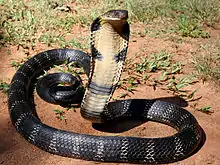 | |
Conservation status | |
| Scientific classification | |
| Kingdom: | Animalia |
| Phylum: | Chordata |
| Class: | Reptilia |
| Order: | Squamata |
| Suborder: | Serpentes |
| Family: | Elapidae |
| Subfamily: | Elapinae |
| Genus: | Ophiophagus Günther, 1864 |
| Species: | O. hannah |
| Binomial name | |
| Ophiophagus hannah Cantor, 1836 | |
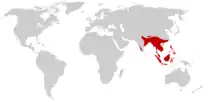 | |
Distribution of the king cobra | |
| Synonyms | |
|
Genus-level:
| |
Like most cobras and mambas, the king cobra's threat display includes spreading its neck-flap, raising its head upright, puffing, and hissing. Despite its fearsome reputation, the king cobra avoids confrontation with humans whenever possible. When provoked, however, it is capable of striking a target at long range and well above the ground. Rather than biting and retreating, it may sustain its bite and inject a large quantity of venom, which is a medical emergency.[4][5]
Regarded as the national reptile of India,[6] this species has an eminent position in mythology and folk traditions of India, Bangladesh, Sri Lanka and Myanmar.[7][8] Threatened by habitat destruction, the king cobra has been listed as Vulnerable on the IUCN Red List since 2010.[1]
Taxonomy
The king cobra is also referred to by the common name "hamadryad", especially in older literature. Hamadryas hannah was the scientific name used by Danish naturalist Theodore Edward Cantor in 1836 who described four king cobra specimens, three captured in the Sundarbans and one in the vicinity of Kolkata.[9] Naja bungarus was proposed by Hermann Schlegel in 1837 who described a king cobra zoological specimen from Java.[10] In 1838, Cantor proposed the name Hamadryas ophiophagus for the king cobra and explained that it has dental features intermediate between the genera Naja and Bungarus.[11] Naia vittata proposed by Walter Elliot in 1840 was a king cobra caught offshore near Chennai that was floating in a basket.[12] Hamadryas elaps proposed by Albert Günther in 1858 were king cobra specimens from the Philippines and Borneo. Günther considered both N. bungarus and N. vittata a variety of H. elaps.[13] The genus Ophiophagus was proposed by Günther in 1864.[14] The name is derived from its propensity to eat snakes.[15]
Naja ingens proposed by Alexander Willem Michiel van Hasselt in 1882 was a king cobra captured near Tebing Tinggi in northern Sumatra.[16]
Ophiophagus hannah was accepted as the valid name for the king cobra by Charles Mitchill Bogert in 1945 who argued that it differs significantly from Naja species.[17] A genetic analysis using cytochrome b,[18] and a multigene analysis showed that the king cobra was an early offshoot of a genetic lineage giving rise to the mambas, rather than the Naja cobras.[19]
A phylogenetic analysis of mitochondrial DNA showed that specimens from Surattani and Nakhon Si Thammarat Provinces in southern Thailand form a deeply divergent clade from those from northern Thailand, which grouped with specimens from Myanmar and Guangdong in southern China.[20]
Description
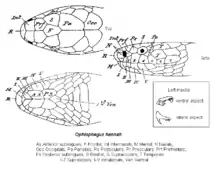
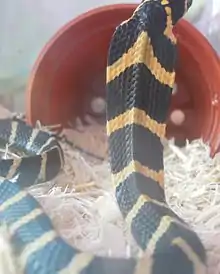
The king cobra's skin is olive green with black and white bands on the trunk that converge to the head. The head is covered by 15 drab coloured and black edged shields. The muzzle is rounded, and the tongue black. It has two fangs and 3–5 maxillar teeth in the upper jaw, and two rows of teeth in the lower jaw. The nostrils are between two shields. The large eyes have a golden iris and round pupils. Its hood is oval shaped and covered with olive green smooth scales and two black spots between the two lowest scales. Its cylindrical tail is yellowish green above and marked with black.[9] It has a pair of large occipital scales on top of the head, 17 to 19 rows of smooth oblique scales on the neck, and 15 rows on the body. Juveniles are black with chevron shaped white, yellow or buff bars that point towards the head.[21] Adult king cobras are 3.18 to 4 m (10.4 to 13.1 ft) long. The longest known individual measured 5.85 m (19.2 ft).[3] Ventral scales are uniformly oval shaped. Dorsal scales are placed in an oblique arrangement.[22]
The king cobra is sexually dimorphic, with males being larger and paler in particular during the breeding season. Males captured in Kerala measured up to 3.75 m (12.3 ft) and weighed up to 10 kg (22 lb). Females captured had a maximum length of 2.75 m (9 ft 0 in) and a weight of 5 kg (11 lb).[23] The largest known king cobra was 5.59 m (18 ft 4 in) long and captured in Thailand.[24] It differs from other cobra species by size and hood. It is larger, has a narrower and longer stripe on the neck.[4]
The head of a mature snake can be quite massive and bulky in appearance. Like most extant snakes, due to macrostomy, it can expand its jaws to swallow large prey items. It has proteroglyph dentition, meaning it has two short, fixed fangs in the front of the mouth, which channel venom into the prey. These are behind the usual "nine-plate" arrangement typical of colubrids and elapids, and are unique to the king cobra. The king cobra typically weighs about 6 kg (13 lb). A captive one at the London Zoo grew to 5.71 m (18.7 ft) before being euthanised upon the outbreak of World War II. The heaviest wild specimen was caught at Royal Island Club in Singapore in 1951, which weighed 12 kg (26 lb) and measured 4.8 m (16 ft). An individual kept at Bronx Zoo weighed 12.7 kg (28 lb) and was 4.4 m (14 ft) long in 1972.
Distribution and habitat
The king cobra has a wide distribution in South and Southeast Asia. It occurs up to an elevation of 2,000 m (6,600 ft) from the Terai in India and southern Nepal to the Brahmaputra River basin in Bhutan and northeast India, Bangladesh and to Myanmar, southern China, Cambodia, Thailand, Laos, Vietnam, Malaysia, Singapore, Indonesia and the Philippines.[1]
In northern India, it has been recorded in Garhwal and Kumaon, and in the Shivalik and terai regions of Uttarakhand and Uttar Pradesh.[25][26][27] In northeast India, the king cobra has been recorded in northern West Bengal, Sikkim, Assam, Meghalaya, Arunachal Pradesh, Nagaland, Manipur and Mizoram.[28][29] In the Eastern Ghats, it occurs from Tamil Nadu and Andhra Pradesh to coastal Odisha, and also in Bihar and southern West Bengal, especially the Sundarbans.[9][28][30] In the Western Ghats, it was recorded in Kerala, Karnataka and Maharashtra, and also in Gujarat.[28][31][23][32] It also occurs on Baratang Island in the Great Andaman chain.[33]
Behaviour and ecology

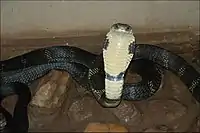
Like other snakes, a king cobra receives chemical information via its forked tongue, which picks up scent particles and transfers them to a sensory receptor (Jacobson's organ) located in the roof of its mouth.[2] When it detects the scent of prey, it flicks its tongue to gauge the prey's location, with the twin forks of the tongue acting in stereo. It senses earth-borne vibration and detects moving prey almost 100 m (330 ft) away.
Following envenomation, it swallows its prey whole. Because of its flexible jaws, it can swallow prey much larger than its head. It is considered diurnal because it hunts during the day, but has also been seen at night, rarely.[2]
Diet
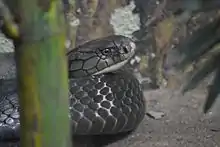
The king cobra is an apex predator and dominant over all other snakes except large pythons.[34] Its diet consists primarily of other snakes and lizards, including Indian cobra, banded krait, rat snake, pythons, green whip snake, keelback, banded wolf snake and Blyth's reticulated snake.[35] It also hunts Malabar pit viper and hump-nosed pit viper by following their odour trails.[36] In Singapore, one was observed swallowing a clouded monitor.[37] When food is scarce, it also feeds on other small vertebrates, such as birds, and lizards. In some cases, the cobra constricts its prey using its muscular body, though this is uncommon. After a large meal, it lives for many months without another one because of its slow metabolic rate.[2][38]
Defense
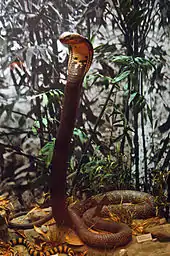
The king cobra is not considered aggressive.[39] It usually avoids humans and slinks off when disturbed, but is known to aggressively defend incubating eggs and attack intruders rapidly. When alarmed, it raises the front part of its body, extends the hood, shows the fangs and hisses loudly.[35][40] Wild king cobras encountered in Singapore appeared to be placid, but reared up and struck in self defense when cornered.[41]
The king cobra possesses a potent neurotoxic venom and death can occur in as little as 30 minutes after being bitten.[42] Most victims bitten by king cobras are snake charmers.[42] Hospital records in Thailand indicate that bites from king cobras are very uncommon.[43][44]
The king cobra can be easily irritated by closely approaching objects or sudden movements. When raising its body, the king cobra can still move forward to strike with a long distance, and people may misjudge the safe zone. It can deliver multiple bites in a single attack.[5]
Growling hiss
The hiss of the king cobra is a much lower pitch than many other snakes and many people thus liken its call to a "growl" rather than a hiss. While the hisses of most snakes are of a broad-frequency span ranging from roughly 3,000 to 13,000 Hz with a dominant frequency near 7,500 Hz, king cobra growls consist solely of frequencies below 2,500 Hz, with a dominant frequency near 600 Hz, a much lower-sounding frequency closer to that of a human voice. Comparative anatomical morphometric analysis has led to a discovery of tracheal diverticula that function as low-frequency resonating chambers in king cobra and its prey, the rat snake, both of which can make similar growls.[45]
Reproduction

The female is gravid for 50 to 59 days.[3] The king cobra is the only snake that builds a nest using dry leaf litter, starting from late March to late May.[46] Most nests are located at the base of trees, are up to 55 cm (22 in) high in the center and 140 cm (55 in) wide at the base. They consist of several layers and have mostly one chamber, into which the female lays eggs.[47] Clutch size ranges from 7 to 43 eggs, with 6 to 38 eggs hatching after incubation periods of 66 to 105 days. Temperature inside nests is not steady but varies depending on elevation from 13.5 to 37.4 °C (56.3 to 99.3 °F). Females stay by their nests between two and 77 days. Hatchlings are between 37.5 and 58.5 cm (14.8 and 23.0 in) long and weigh 9 to 38 g (0.32 to 1.34 oz).[46]
The venom of hatchlings is as potent as that of the adults. They may be brightly marked, but these colours often fade as they mature. They are alert and nervous, being highly aggressive if disturbed.[4]
The average lifespan of a wild king cobra is about 20 years.
Venom

The king cobra's venom consists of cytotoxins and neurotoxins, including alpha-neurotoxins and three-finger toxins.[48][49][50][51] Other components have cardiotoxic effects.[52] Its venom is produced in anatomical glands named postorbital venom glands.[53]
It can deliver up to 420 mg venom in dry weight (400–600 mg overall) per bite,[54] with a LD50 toxicity in mice of 1.28 mg/kg through intravenous injection,[55] 1.5 to 1.7 mg/kg through subcutaneous injection,[56] and 1.644 mg/kg through intraperitoneal injection.[54][57][58] For research purposes, up to 1 g of venom was obtained through milking.[59]
The toxins affect the victim's central nervous system, resulting in severe pain, blurred vision, vertigo, drowsiness, and eventually paralysis. If the envenomation is serious, it progresses to cardiovascular collapse, and the victim falls into a coma. Death soon follows due to respiratory failure. The affected person can die within 30 minutes of envenomation.[42] Ohanin, a protein component of the venom, causes hypolocomotion and hyperalgesia in mammals.[60] Large quantities of antivenom may be needed to reverse the progression of symptoms.[5]
Polyvalent antivenom of equine origin is produced by Haffkine Institute and King Institute of Preventive Medicine and Research in India.[61] A polyvalent antivenom produced by the Thai Red Cross Society can effectively neutralize venom of the king cobra.[62] In Thailand, a concoction of turmeric root has been clinically shown to create a strong resilience against the venom of the king cobra when ingested.[63][64] Proper and immediate treatments are critical to avoid death. Successful precedents include a client who recovered and was discharged in 10 days after being treated by accurate antivenom and inpatient care.[42]
Not all king cobra bites result in envenomation, but they are often considered for medical importance.[65] Clinical mortality rates vary between different regions and depend on many factors, such as local medical advancement. A Thai survey reports 10 deaths out of 35 patients received for king cobra bites, whose fatality rate posed (28%) is higher than those of other cobra species.[66] The Department of Clinical Toxinology of the University of Adelaide gives this serpent a general untreated fatality rate of 50–60%, implying that the snake has about a half chance to deliver bites involving nonfatal quantities of venom.[67]
Threats
In Southeast Asia, the king cobra is threatened foremost by habitat destruction owing to deforestation and expansion of agricultural land. It is also threatened by poaching for its meat, skin and for use in traditional Chinese medicine.[1]
Conservation
The king cobra is listed in CITES Appendix II. It is protected in China and Vietnam.[1] In India, it is placed under Schedule II of Wildlife Protection Act, 1972. Killing a king cobra is punished with imprisonment of up to six years.[68]
Cultural significance
A ritual in Myanmar involves a king cobra and a female snake charmer. The charmer is a priestess who is usually tattooed with three pictograms and kisses the snake on the top of its head at the end of the ritual.[8][38]
Members of the Pakokku clan tattoo themselves with ink mixed with cobra venom on their upper bodies in a weekly inoculation that they believe would protect them from the snake, though no scientific evidence supports this.[38][69]
References
- Stuart, B.; Wogan, G.; Grismer, L.; Auliya, M.; Inger, R.F.; Lilley, R.; Chan-Ard, T.; Thy, N.; Nguyen, T.Q.; Srinivasulu, C.; Jelić, D. (2012). "Ophiophagus hannah". IUCN Red List of Threatened Species. 2012: e.T177540A1491874. doi:10.2305/IUCN.UK.2012-1.RLTS.T177540A1491874.en. Retrieved 20 November 2021.
- Mehrtens, J. (1987). "King Cobra, Hamadryad (Ophiophagus hannah)". Living Snakes of the World. New York: Sterling. p. 263–. ISBN 0-8069-6461-8.
- Chanhome, L.; Cox, M. J.; Vasaruchapong, T.; Chaiyabutr, N.; Sitprija, V. (2011). "Characterization of venomous snakes of Thailand". Asian Biomedicine 5 (3): 311–328.
- O'Shea, M. (2008). Venomous snakes of the world. London, Cape Town, Sydney, Auckland: Bloomsbury Publishing Plc. ISBN 9781847730862.
- Davidson, T. "Immediate First Aid". University of California, San Diego. Retrieved 24 September 2011.
- "King Cobra – National Reptile of India". indiamapped.
- Minton, S.A. Jr. and M.R. Minton (1980). Venomous reptiles. New York: Charles Scribner's Sons. ISBN 9780684166261.
- Platt, S.G.; Ko, W.K. and Rainwater, T.R. (2012). "On the Cobra Cults of Myanmar (Burma)". Chicago Herpetological Society. 47 (2): 17–20.
{{cite journal}}: CS1 maint: multiple names: authors list (link) - Cantor, T. E. (1836). "Sketch of an undescribed hooded serpent, with fangs and maxillar teeth". Asiatic Researches. 19: 87–93.
- Schlegel, H. (1837). "Le Naja Bongare. N. bungarus". Essai sur la physionomie des serpens. Amsterdam: Schonekat. p. 476.
- Cantor, T. E. (1838). "A notice of the Hamadryas, a genus of hooded serpent with poisonous fangs and maxillary teeth". Proceedings of the Zoological Society of London. 6: 72–75.
- Elliot, W. (1840). "Description of a New Species of Naga, or Cobra de Capello". Madras Journal of Literature and Science. 11: 39–41.
- Günther, A. (1858). Catalogue of colubrine snakes in the collection of the British Museum. London: Printed by order of the Trustees. p. 219.
- Günther, A. C. L. G. (1864). "Ophiophagus, Gthr.". The Reptiles of British India. London: Ray Society. pp. 340–342.
- O'Shea, M. (2005). Venomous Snakes of the World. New Jersey, USA: Princeton University Press. pp. 96–97. ISBN 978-0-691-12436-0.
- Van Hasselt, A. W. M. (1882). "Eene Monster-Naja". Verslagen en Mededeelingen der Koninklijke Akademie van Wetenschappen. 2. 17: 140–143.
- Bogert, C. M. (1945). "Hamadryas Preoccupied for the King Cobra". Copeia. 1945 (1): 47. doi:10.2307/1438180. JSTOR 1438180.
- Slowinski, J. B.; Keogh, J. S. (2000). "Phylogenetic Relationships of Elapid Snakes Based on Cytochrome b mtDNA Sequences" (PDF). Molecular Phylogenetics and Evolution. 15 (1): 157–164. doi:10.1006/mpev.1999.0725. PMID 10764543.
- Figueroa, A.; McKelvy, A. D.; Grismer, L. L.; Bell, C. D.; Lailvaux, S. P. (2016). "A species-level phylogeny of extant snakes with description of a new colubrid subfamily and genus". PLOS ONE. 11 (9): e0161070. Bibcode:2016PLoSO..1161070F. doi:10.1371/journal.pone.0161070. PMC 5014348. PMID 27603205.
- Suntrarachun, S.; Chanhome, L.; Sumontha, M. (2014). "Phylogenetic analysis of the king cobra, Ophiophagus hannah in Thailand based on mitochondrial DNA sequences". Asian Biomedicine. 8 (2): 269–274. doi:10.5372/1905-7415.0802.289.
- Smith, M. A. (1943). "Naja hannah. Hamadryad, King Cobra". The Fauna of British India, Ceylon and Burma, including the whole of the Indo-Chinese Subregion. Vol. Reptilia and Amphibia. III. – Serpentes. London: Taylor and Francis. pp. 436–438.
- Martin, D. L. (2012). "Identification of Reptile Skin Products Using Scale Morphology". In J. E. Huffman, J. R. Wallace (ed.). Wildlife Forensics: Methods and Applications. Oxford: John Wiley & Sons. pp. 161–199. ISBN 9781119954293.
- Shankar, P. G.; Ganesh, S. R.; Whitaker, R.; Prashanth, P. (2013). "King Cobra Ophiophagus hannah (Cantor, 1836) encounters in human-modified rainforests of the Western Ghats, India". Hamadryad (36): 62–68.
- Burton, R. W. (1950). "The record hamadryad or king cobra [Naja hannah (Cantor)] and lengths and weights of large specimens". The Journal of the Bombay Natural History Society. 49: 561–562.
- Singh, A.; Joshi, R. (2016). "A first record of the King Cobra Ophiophagus hannah (Reptilia: Squamata: Elapidae) nest from Garhwal Himalaya, northern India". Zoo's Print. 31: 9–11.
- Dolia, J. (2018). "Notes on the distribution and natural history of the King Cobra (Ophiophagus hannah Cantor, 1836) from the Kumaon Hills of Uttarakhand, India". Herpetology Notes. 11: 217–222.
- Kanaujia, A., Kumar, A.; Kumar, A. (2017). "Herpetofauna of Uttar Pradesh, India". Biological Forum. 9 (1): 118–130.
{{cite journal}}: CS1 maint: multiple names: authors list (link) - Wallach, V.; Williams, K.L.; Boundy, J. (2014). Snakes of the world: A catalogue of living and extinct species. Florida: CRC Press, Taylor and Francis Group. pp. 507–508. ISBN 9781482208481.
- Bashir, T.; Poudyal, K.; Bhattacharya, T.; Sathyakumar, S.; Subba, J. B. (2010). "Sighting of King Cobra Ophiophagus hannah in Sikkim, India: a new altitude record for the northeast". Journal of Threatened Taxa. 2 (6): 990–991. doi:10.11609/JoTT.o2438.990-1.
- Murthy, K.L.N.; Murthy, K.V.R. (2012). "Sightings of King Cobra Ophiophagus hannah in northern coastal Andhra Pradesh". Reptile Rap. 14: 29–32.
- Yadav, O. V.; Yankanchi, S. R. (2015). "Occurence [sic] of Ophiophagus hannah Cantor, 1836 (Squamata, Elapidae) in Tillari, Maharashtra, India". Herpetology Notes. 8: 493–494.
- Palot, M. J. (2015). "A checklist of reptiles of Kerala, India". Journal of Threatened Taxa. 7 (13): 8010–8022. doi:10.11609/jott.2002.7.13.8010-8022.
- Manchi, S.; Sankaran, R. (2009). "Predators of swiftlets and their nests in the Andaman and Nicobar Islands". Indian Birds. 5 (4): 118–120.
- Marshall, B.M.; Strine, C.T.; Jones, M.D.; Theodorou, A.; Amber, E.; Waengsothorn, S.; Suwanwaree, P.; Goode, M. (2018). "Hits close to home: repeated persecution of King Cobras (Ophiophagus hannah) in northeastern Thailand". Tropical Conservation Science. 11: 1–14. doi:10.1177/1940082918818401.
- Wall, F. (1924). "The Hamadryad or King Cobra Naja hannah (Cantor)". The Journal of the Bombay Natural History Society. 30 (1): 189–195.
- Bhaisare, D.; Ramanuj, V.; Shankar, P. G.; Vittala, M.; Goode, M.; Whitaker, R. (2010). "Observations on a wild King Cobra (Ophiophagus hannah), with emphasis on foraging and diet". IRCF Reptiles & Amphibians. 17 (2): 95–102.
- Kurniawan, A.; Lee, G.; bin Tohed, N.; Low, M.-R. (2018). "King cobra feeding on a monitor lizard at night" (PDF). Singapore Biodiversity Records. 2018: 63.
- Coborn, J. (1991). The Atlas of Snakes of the World. TFH Publications. pp. 30, 452. ISBN 978-0-86622-749-0.
- Tweedie, M. W. F. (1983). The Snakes of Malaya. Singapore: Singapore National Printers Ltd. p. 142. OCLC 686366097.
- Greene, H. W. (1997). "Antipredator tactics of snakes". Snakes: The Evolution of Mystery in Nature. California, USA: University of California Press. pp. 103–111. ISBN 0-520-22487-6.
- Lim, K. K. P.; Leong, T. M.; Lim, L. K. (2011). "The king cobra, Ophiophagus hannah (Cantor) in Singapore (Reptilia: Squamata: Elapidae)" (PDF). Nature in Singapore. 4: 143–156.
- Tin-Myint; Rai-Mra; Maung-Chit; Tun-Pe; Warrell, D. (1991). "Bites by the king cobra (Ophiophagus hannah) in Myanmar: Successful treatment of severe neurotoxic envenoming". The Quarterly Journal of Medicine. 80 (293): 751–762. doi:10.1093/oxfordjournals.qjmed.a068624. PMID 1754675.
- Viravan, C.; Looareesuwan, S.; Kosakarn, W.; Wuthiekanun, V.; McCarthy, C. J.; Stimson, A. F.; Warrell, D. A. (1992). "A national hospital-based survey of snakes responsible for bites in Thailand". Transactions of the Royal Society of Tropical Medicine and Hygiene. 86 (1): 100–106. doi:10.1016/0035-9203(92)90463-m. PMID 1566285.
- Pochanugool, C.; Wilde, H.; Bhanganada, K.; Chanhome, L.; Cox, M. J.; Chaiyabutr, N.; Sitprija, V. (1998). "Venomous snakebite in Thailand II: Clinical experience". Military Medicine. 163 (5): 318–323. doi:10.1093/milmed/163.5.318. PMID 9597849.
- Young, B. A. (1991). "Morphological basis of "growling" in the king cobra, Ophiophagus hannah". Journal of Experimental Zoology. 260 (3): 275–287. doi:10.1002/jez.1402600302. PMID 1744612.
- Whitaker, N.; Shankar, P. G.; Whitaker, R. (2013). "Nesting ecology of the King Cobra (Ophiophagus hannah) in India" (PDF). Hamadryad. 36 (2): 101–107.
- Hrima, V. L.; Sailo, V. H.; Fanai, Z.; Lalronunga, S.; Lalrinchhana, C. (2014). "Nesting ecology of the King Cobra, Ophiophagus hannah, (Reptilia: Squamata: Elapidae) in Aizawl District, Mizoram, India". In Lalnuntluanga; Zothanzama, J.; Lalramliana; Lalduhthlana; Lalremsanga, H. T. (eds.). Issues and Trends of Wildlife Conservation in Northeast India. Aizawl: Mizo Academy of Sciences. pp. 268–274. ISBN 9788192432175.
- Chang, L.-S.; Liou, J.-C.; Lin, S.-R.; Huang, H.-B. (2002). "Purification and characterization of a neurotoxin from the venom of Ophiophagus hannah (king cobra)". Biochemical and Biophysical Research Communications. 294 (3): 574–578. doi:10.1016/S0006-291X(02)00518-1. PMID 12056805.
- He, Y. Y.; Lee, W. H.; Zhang, Y. (2004). "Cloning and purification of alpha-neurotoxins from king cobra (Ophiophagus hannah)". Toxicon. 44 (3): 295–303. doi:10.1016/j.toxicon.2004.06.003. PMID 15302536.
- Li, J.; Zhang, H.; Liu, J.; Xu, K. (2006). "Novel genes encoding six kinds of three-finger toxins in Ophiophagus hannah (king cobra) and function characterization of two recombinant long-chain neurotoxins". Biochemical Journal. 398 (2): 233–342. doi:10.1042/BJ20060004. PMC 1550305. PMID 16689684.
- Roy, A.; Zhou, X.; Chong, M. Z.; d'Hoedt, D.; Foo, C. S.; Rajagopalan, N.; Nirthanan, S.; Bertrand, D.; Sivaraman, J.; Kini, R. M. (2010). "Structural and Functional Characterization of a Novel Homodimeric Three-finger Neurotoxin from the Venom of Ophiophagus hannah (King Cobra)". The Journal of Biological Chemistry. 285 (11): 8302–8315. doi:10.1074/jbc.M109.074161. PMC 2832981. PMID 20071329.
- Rajagopalan, N.; Pung, Y. F.; Zhu, Y. Z.; Wong, P. T. H.; Kumar, P. P.; Kini, R. M. (2007). "β-Cardiotoxin: A new three-finger toxin from Ophiophagus hannah (King Cobra) venom with beta-blocker activity". The FASEB Journal. 21 (13): 3685–3695. doi:10.1096/fj.07-8658com. PMID 17616557. S2CID 21235585.
- Vonk, Freek J.; Casewell, Nicholas R.; Henkel, Christiaan V.; Heimberg, Alysha M.; Jansen, Hans J.; McCleary, Ryan J. R.; Kerkkamp, Harald M. E.; Vos, Rutger A.; Guerreiro, Isabel; Calvete, Juan J.; Wüster, Wolfgang (17 December 2013). "The king cobra genome reveals dynamic gene evolution and adaptation in the snake venom system". Proceedings of the National Academy of Sciences. 110 (51): 20651–20656. Bibcode:2013PNAS..11020651V. doi:10.1073/pnas.1314702110. ISSN 0027-8424. PMC 3870661. PMID 24297900.
- Séan Thomas & Eugene Griessel – Dec 1999. "LD50 (Archived)". Archived from the original on 1 February 2012.
- Ganthavorn, S. (1969). "Toxicities of Thailand snake venoms and neutralization capacity of antivenin". Toxicon. 7 (3): 239–241. doi:10.1016/0041-0101(69)90012-9. PMID 5358069.
- Broad, A. J.; Sutherland, S. K.; Coulter, A. R. (1979). "The lethality in mice of dangerous Australian and other snake venom" (PDF). Toxicon. 17 (6): 661–664. doi:10.1016/0041-0101(79)90245-9. PMID 524395.
- Engelmann, Wolf-Eberhard (1981). Snakes: Biology, Behavior, and Relationship to Man. Leipzig; English version NY, USA: Leipzig Publishing; English version published by Exeter Books (1982). pp. 222. ISBN 0-89673-110-3.
- Handbook of clinical toxicology of animal venoms and poisons. Vol. 236. USA: CRC Press. 1995. ISBN 0-8493-4489-1.
- Tan, Choo Hock; Tan, Kae Yi; Fung, Shin Yee; Tan, Nget Hong (10 September 2015). "Venom-gland transcriptome and venom proteome of the Malaysian king cobra (Ophiophagus hannah)". BMC Genomics. 16 (1): 687. doi:10.1186/s12864-015-1828-2. ISSN 1471-2164. PMC 4566206. PMID 26358635.
- Pung, Y. F.; Kumar, S. V.; Rajagopalan, N.; Fry, B. G.; Kumar, P. P.; Kini, R. M. (2006). "Ohanin, a novel protein from king cobra venom: Its cDNA and genomic organization". Gene. 371 (2): 246–256. doi:10.1016/j.gene.2005.12.002. PMID 16472942.
- Whitaker, R.; Whitaker, S. (2012). "Venom, antivenom production and the medically important snakes of India" (PDF). Current Science. 103 (6): 635–643.
- Leong, P. K.; Sim, S. M.; Fung, S. Y.; Sumana, K.; Sitprija, V.; Tan, N. H. (2012). "Cross Neutralization of Afro-Asian Cobra and Asian Krait Venoms by a Thai Polyvalent Snake Antivenom (Neuro Polyvalent Snake Antivenom)". PLOS Neglected Tropical Diseases. 6 (6): e1672. doi:10.1371/journal.pntd.0001672. PMC 3367981. PMID 22679522.
- Ernst, C. H.; Evelyn, M. (2011). "Treatment of envenomation by reptiles". Venomous Reptiles of the United States, Canada, and Northern Mexico. Vol. 1: Heloderma, Micruroides, Micrurus, Pelamis, Agkistrodon, Sistrurus. Baltimore: Johns Hopkins University Press. pp. 33–46. ISBN 978-0-8018-9875-4.
- Salama, R.; Sattayasai, J.; Gande, A. K.; Sattayasai, N.; Davis, M.; Lattmann, E. (2012). "Identification and evaluation of agents isolated from traditionally used herbs against Ophiophagus hannah venom". Drug Discoveries & Therapeutics. 6 (1): 18–23.
- Mathew, Gera, JL, T. "Ophitoxaemia (Venomous snakebite)". MEDICINE ON-LINE. Retrieved 20 October 2013.
- Norris MD, Robert L. "Cobra Envenomation". Medscape. Retrieved 22 October 2013.
- "Ophiophagus hannah". University of Adelaide.
- Sivakumar, B. (2012). "King cobra under threat, put on red list". The Times of India. Archived from the original on 1 February 2013.
- Murphy, J. C. (2010). Secrets of the Snake Charmer: Snakes in the 21st Century. iUniverse. ISBN 978-1-4502-2127-6.

